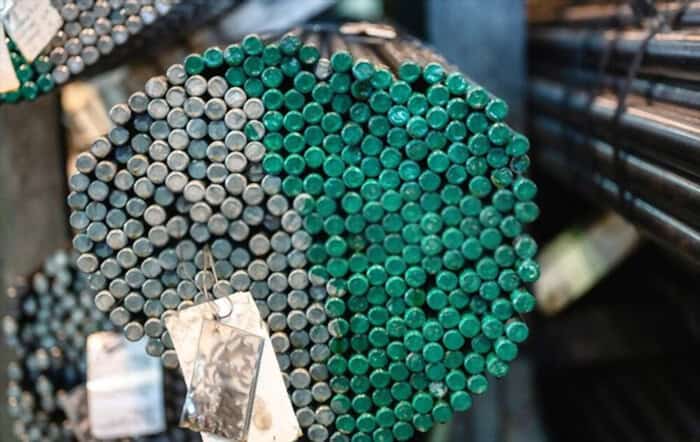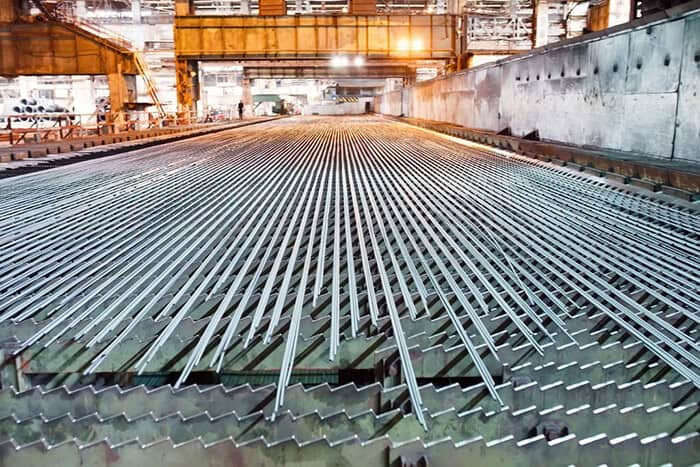Transmission steel is also generally called the transmission shaft. Unlike others, this steel is mostly used for pulling operations. It is used for all kinds of parts that need transmission shaft pulling, especially in the automotive sectors.
The transmission shaft must be correctly selected so that the towing process is more efficient and no parts are damaged while towing. Transmission steels are those that have the necessary properties to withstand the force that will be applied at this stage.
In addition, at this stage, transmission steels and shafts vary according to the components and alloys they contain. This makes it easier to decide which part or type of steel to use in the industry. Transmission steels, like all other steels, are divided into certain groups. This group separation is made in line with the amount of carbon and manganese in the steel. In other words, transmission shafts with low carbon and high manganese are classified into different groups, as are steels that combine with other components or increase the carbon content.
These groups also express in which sectors transmission steels will be used. In this way, the purchase, use and selection phases are easier in transmission shafts than in other steels. For these reasons, transmission steel is employed in numerous sectors and components, including machinery.
What is Transmission Steel?
Transmisyon çeliği nedir, sorusu bu mili satın almak isteyen bireylerin sıklıkla sorduğu sorulardan biridir. Transmisyon mili olarak da adlandırılan bu çelikler, üst düzey bir çekme kuvvetine sahiptir. Bu sayede herhangi bir kırılma veya bozulma olmadan çeşitli parçaların kuvvet aktarabilmelerine olanak sağlarlar.
The most important features of these steels are their round cut. Transmission shafts with a round shape can be of different thicknesses. The thickness is generally selected for the areas where the steel will be used. For this reason, people who want to buy transmission steel should first know where they want to use these steels. Otherwise, the steel may not be able to carry the required force, and various fractures may occur during towing.
Transmission shafts, also known as high-strength steel in general, can carry a significant amount of force. The need for these steels is met by various factories, as with all other steels. Steel factories continue to produce high-strength steel, specifically transmission steels . These steels are used continuously in parts produced in different industrial areas.

What is Transmission?
The question of what transmission is and what transmission means is among the most important issues that are constantly sought answers. Transmission, which gives its name to the shaft and steel, is especially important for various cars and vehicles. A part that allows the vehicle or any part to move horizontally is called a transmission. All of the vehicles produced today have a transmission and transmission shaft.
The main production material of these shafts is transmission steel. This allows the steel transmission shafts to be more durable. This extends the life of vehicles and other machines equipped with transmissions. If this shaft or steel is damaged in any way, it is necessary to purchase a new transmission shaft.
For this reason, every part with a transmission is one of the most important materials for automotive or machinery. In addition, this material contains different levels of carbon and manganese. In general, carbon alloy or manganese uptake can be increased in transmission steels containing carbon and manganese. Similarly, the increase process can be reversed to determine the power of the shafts.
Transmission Shafts and Their Applications
The areas of use of the transmission shaft are generally quite wide. This is because these shafts and steels have a very high quality and high level of performance. However, transmission shafts are preferred in almost every field. The areas where these shafts are used today are as follows;
- The transmission shaft is one of the most important components in the automotive industry.
- It is widely used in the defense industry due to its impact resistance.
- It makes spare parts more durable. As a result, transmission steels are preferred for the manufacture of spare parts.
- These shafts are also popular in the manufacturing of white goods. Transmission shafts are a must, especially for durable parts.
- Transmission shafts are also increasingly popular in the construction industry.
The transmission steel used in the above areas has a very high level of quality. In this respect, it can be preferred for different areas today.
Mechanical Properties of Transmission Steels
The mechanical properties of transmission steels are of great importance in terms of durability and performance. This section focuses on the mechanical properties of transmission steels, including hardness, weldability and tensile strength.
Hardness
The hardness of transmission steels determines the material's ability to resist. High hardness values ensure that steel material is resistant to abrasion and deformation. Therefore, transmission steels should have high hardness values.
Weldability
The weldability of transmission steels determines how robustly the material can be welded. A good weldability ensures that the transmission systems operate safely and durably. Weldability refers to the ability of steel material to be welded without changing form and without the risk of cracking.
Drawing Process
The Drawing Process of transmission steels is a factor that determines the durability and strength of the material. The drawing processliterally reveals the resistance and stress values of the steel material. Transmission steels with high drawing strength are preferred for more reliable and performance transmission systems.

Transmission Shaft and Production Process
We will look at the transmission steel manufacturing process and various production methods. While transmission steels are usually produced by the cold drawing method, sometimes production can be carried out by hot rolled or machining .
The transmission shaft is a critical component of transmission systems that must be both long-lasting and efficient. The production of these steels is a process that requires special processes and precise machines.
Cold Drawing
The cold drawing methodis a frequently used method in the production of transmission steels. In this method, a round bar is made cold and transformed into the desired shape with the help of a set of special molds. The cold drawing processhelps to increase the strength of the steels and to have the desired dimensions.
The cold drawing method has the advantage of optimizing the surface quality and size tolerances of steels. In this way, the transmission steels produced can work with higher precision and provide durability.
Hot Rolled Steel
In some cases, transmission steels can be produced using hot-rolled steel . Hot-rolled steelis a material that is processed at high temperatures and shaped in special machines. Steels produced by this method can be made in larger sizes and complex shapes.
Hot-rolled steel allows transmission steels to offer advantages such as high temperature resistance, better formability and high strength. However, surface roughness and dimensional tolerances may be lower than those obtained through cold drawing.
Machining
The machining method can sometimes be a preferred method in the production of transmission steels. In this method, chips are removed from the metal from the machined steel part and the desired shape is obtained. Machiningis a suitable option for transmission steels where complex geometries and high precision are required.
Machining provides the ability to process steels in desired sizes and complex shapes. Transmission steels produced by this method are an ideal option for use in high-performance transmission systems because they offer excellent surface quality and dimensional stability.
Transmission Steel Grades
Transmission steel is a type of steel with a wide range of grades, defined more by its breaking strength and tensile strength rather than its chemical composition. These materials are specified as St37-2, St44-2, St52-3, etc. to symbolize tensile strength. Since carbon (C) levels are low, the increase in strength increases with the manganese (Mn) level in its content. A tensile strength of 370 N/mm² is required. The term gear steel is generally used for SAE 1008-SAE 1010-SAE 1012-SAE 1013 and ST-37 steels. The cold drawn form of these materials is referred to as gear in the commercial market.
Gear steels offer high weldability due to their low carbon content. This makes it more convenient and preferable for use in machine parts, automotive equipment shafts, and other manufacturing components that must be welded after or during assembly. Gear steel is easy to process as chip evacuation is not difficult. It is economical compared to vending steels. St44 and St52 materials contain a more durable structure. This is due to the higher concentration of carbon and manganese in them. For example, the non-heat treated SAE 1050 material has nearly identical strength values to the St52 material, which contains nearly half the amount of carbon.
Price Information of Transmission Shaft and Transmission Steel Price
It is not possible to give a clear range on transmission shaft prices . The reason for this is that the prices of transmission steel and shafts vary according to many factors. Transmission shafts, which are constantly produced by various factories, can be sold at a variety of prices.
For example, especially square, hexagonal or round varieties may cause prices to change. In addition, the weight and length of the shafts are among the important factors affecting prices. These products, which are generally sold at affordable prices, are among the most cost-effective steels because they can be used in the long term.
Another factor that causes the prices of shafts to change is the alloy of steel. Transmission steel can be produced using different alloys. The most important of these is the amount of carbon and the amount of manganese. Excess of these components may cause the prices of the shafts to increase. To obtain net prices, it is important to seek offers from factories and companies that produce transmission steel .

What are the Transmission Characteristics?
Transmission shaft features are quite high. As a result, it is now widely used in a variety of fields. The characteristics of the transmission shafts, which are preferred in different areas due to their characteristics, durability and long life, are as follows;
- The transmission shafts have various amounts of carbon. In this way, their welding capabilities are at a high level.
- These shafts are also highly resistant to rust. For this reason, they are not easily damaged.
- Transmission shafts are even more affordable than vending steel or other types of steel. For this reason, they are frequently preferred in different sectors.
- Thanks to the transmission shafts, it is possible to assemble and perform various operations more easily in many areas. For this reason, it is often preferred today.
- The surface quality of the shafts is also quite high. In this way, it is possible to obtain a smooth surface in the parts where this steel is used. This is one of the reasons why shafts are preferred.
- The transmission steel, or in other words the shaft, can easily shrink or go into different shapes. This allows for a longer lifespan.
- Transmission steels are extremely resistant to external impacts. It does not break against tensile, elongation and similar conditions.
- Mechanical properties are also important considerations when selecting transmission shafts. This steel has mechanical properties such as easy shrinkage, hardness, impact resistance, tensile strength, and elongation.
Let's list the top 10 facts, statistics, and trends related to “transmission steel”, including resources!
Transmission steel, also known as transmission shafts, is primarily used for pulling operations on a variety of components. (source: Bright Hub Engineering)
Choosing the right transmission steel is very important for a high-performance drawing process and the steel must be able to withstand the applied force. (source: Thomasnet)
Transmission steel is typically divided into different groups based on the amount of carbon and manganese present. (source: AZoM)
The use of transmission steel is common in a variety of industries, including the automotive industry, defense, construction, and appliance manufacturing. (source: ScienceDirect)
Transmission steel is often referred to as “gear steel” due to its high strength, durability and tensile strength. (source: AZoM)
The chemical composition of transmission steel affects fracture strength and tensile strength, and carbon and manganese are primary alloying elements. (source: Bright Hub Engineering)
The low carbon content of transmission steel makes it easy to weld and process, making it a cost-effective material for a variety of manufacturing industries. (source: AZoM)
The most commonly used transmission steel grades include St37-2, St44-2, St52-3, SAE 1008, SAE 1010, SAE 1012, SAE 1013, and ST-37. (source: Bright Hub Engineering)
The price of transmission steel varies with shape, weight, length and alloy composition. (source: Thomasnet)
The high strength, corrosion resistance and ease of processing of transmission steel make it a versatile and important material in many industrial applications. (source: ScienceDirect)

Frequently Asked Questions
Transmission steel is a high-strength type of steel primarily used for drawing processes. It is used for all kinds of parts that need transmission shaft pulling, especially in the automotive sectors.
Transmission steel is used in many sectors such as the automotive sector, defense industry, spare parts production, white goods production and construction sector.
The transmission shaft is a type of high-strength steel shaft that is manufactured using transmission steel. It usually allows various parts to transfer force.
Transmission steel is a type of high-strength steel and is used for drawing operations. The transmission shaft is a type of high-strength steel shaft that is manufactured using transmission steel and allows various parts to transfer force.
When purchasing transmission steel, it is necessary to decide in which area it will be used. The properties such as thickness, length, weight of the steel should also be considered.
Transmission steel and transmission shaft enable various parts to transfer force and enable long-lasting use thanks to their high strength.
Transmission shaft prices are determined depending on the quality, size, processing process of the material forming the shaft and other factors determined by the manufacturer.
The mechanical properties of transmission steels include factors such as hardness, weldability and tensile strength. These properties determine how effective steel is in terms of durability and performance.
Transmission steels have advantages such as low carbon value and ease of processing. They are also offered at competitive prices. You can contact us to getprice information .
High-strength steels are generally preferred in the production of transmission shafts. These steels provide high durability and strength.
